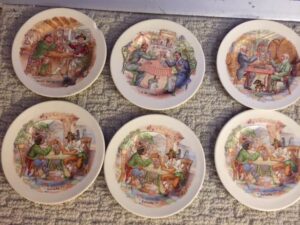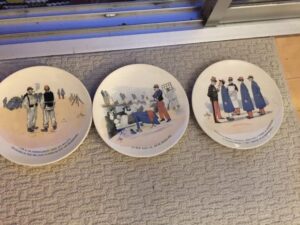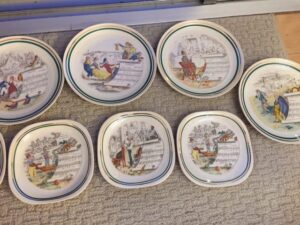 PC collects hors d’oeuvres small plates. The smallest is a set of six from the International Toasts Series by Fondeville Ambassador Ware. Fondeville NY imported these from England in the 1920-1930s. My favorite plate shows two Kilted Scots, toasting with whiskey, saying “Here’s Tae Yooo!” Of course, we have toasts in many languages, and colorful costumes. The value of each of these small plates is $15.
PC collects hors d’oeuvres small plates. The smallest is a set of six from the International Toasts Series by Fondeville Ambassador Ware. Fondeville NY imported these from England in the 1920-1930s. My favorite plate shows two Kilted Scots, toasting with whiskey, saying “Here’s Tae Yooo!” Of course, we have toasts in many languages, and colorful costumes. The value of each of these small plates is $15.
The second set comprises eight stoneware illustrated dishes by Parry Vielle (marked “PV”). Themed French Opera characters and snippets of songs from musical scores, the crudité size at eight inches, comes from the 1940s. The designs are not hand painted, but applied with transfers, much like the decals affixed on a model airplane. People associate PV with Limoges porcelain, but it’s not made of the famous Limoges clay, containing Kaolin. It’s merely decorated in the city of Limoges. Typically hand painted dishes bring more than transfer decorated dishes like these. I value these at $15 a dish.
Interesting Themed Small Plates
 These feature the exploits of the French Foreign Legion, as drawn, cartoon style, by Albert Guillaume in the early 1900s. Opposed to the PV dishes, these are hand painted, the stoneware heavy, and the glaze thick. Two little holes on the back allow wall mounting, showing these were meant to be thought of as art.
These feature the exploits of the French Foreign Legion, as drawn, cartoon style, by Albert Guillaume in the early 1900s. Opposed to the PV dishes, these are hand painted, the stoneware heavy, and the glaze thick. Two little holes on the back allow wall mounting, showing these were meant to be thought of as art.
Guillaume titled this series “Mon Regiment,” of interest to militaria collectors as well as French Faience collectors.
The dishes came from the famous ceramic town of Sarreguemines, probably in the early 20th century. The tradition of ceramics in Sarreguemines goes back to the French Revolution with the town factory established in 1790. Like the themes on the plates themselves (wartime escapades), the French factory suffered from the Franco-Prussian War. The Treaty of Frankfurt in 1871 “gave” Moselle to Germany, and since part of the factory was in Moselle, Sarreguemines became divided.
Faience Style Plates
 The Cazal Family made these charming plates in the early 20th century, which took over one branch of the factory, called Sarreguemines – Dijon – Vitry -le- Francois. The style, with a certain colorful look in both illustrations and images, as well as vivid colors, is the epitome of French faience. Collectors worldwide loved this style in the first and second quarters of the 20th century. This lighthearted French humor, hard to explain, but you know it when you see it, in the style we know as Faience.
The Cazal Family made these charming plates in the early 20th century, which took over one branch of the factory, called Sarreguemines – Dijon – Vitry -le- Francois. The style, with a certain colorful look in both illustrations and images, as well as vivid colors, is the epitome of French faience. Collectors worldwide loved this style in the first and second quarters of the 20th century. This lighthearted French humor, hard to explain, but you know it when you see it, in the style we know as Faience.
The wartime division of the ceramic factory connects with these plates representing images of the French Foreign Legion. Appropriateness of the imagery to the factory must have made this a popular work to make as well as to buy in the day.
The Foreign Legion, created in 1831 as a corps of the French Army, allowed foreign Nationals into the French Army. Legionnaires fought as the Armee d’Afrique, a most famous posting even till the end of the Algerian War in 1962.
Men who experienced the annexation of Alsace and Lorraine by Germany flocked to join the Foreign Legion in order to retain French Citizenship. The Legion announced a call in July 1914 for volunteers to support their adopted country or to fight for the France they knew. In August, on one day in 1914, the Paris Office of the French Foreign Legion accepted 8,000 volunteer soldiers.
A Comical Relationship
These plates show the comical relationship between the OLD Legionnaires, many of them crusty misfits, and the NEW Legionnaires, young and idealistic. However misaligned, the two groups fought for France in Artois, Champagne, Somme, Aisne, Verdun, in the Dardanelles, and on the Macedonian Front, and of course in Algeria. In fact Americans joined the Legion, notably the poet Alan Seiger. Mortally shot Seiger cheered on his fellow Legionnaires as he lay dying. Of course, these dishes are ever so charming, laughing at the war, with that French ebullience.
About 20 years ago these plates would have been worth more than today. Fine kitchens in large mansions used to use the French Country the style. Many a Montecito client remodeled from a French Country kitchen to a postmodern look. These plates tell the story of an intrepid cast of soldiers, in that typical French light satire. Each plate is worth $80.